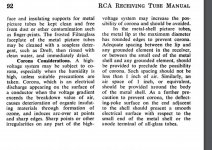that's only a concern with a picture tube running at 30Kv, are you suggesting this happens it tube amps?
Its recommended to observe proper clearange and creepage distancing guidelines.
That's also what the government says about corona. (But I don't think they use exactly the same words.) 😀
There are different standards and thumbs of rule for creepage distances.
UL6500 says
log d = 0.78 log (V/300)
(where d is distance in mm and V voltage)
IPC-9592 says
creepage (mm) = 0.6+Vpeak×0.005
The latter is a newer standard, though, so should be safer to follow.
I think the latter is also safer when talking about high voltages.
As this is not my main area of expertise, has anyone any other standard to add?
I wouldnt be worrying too much about corona until you're in the kV range.
Creepage and maintaining clearances is different. E.g. a PCB may track at more usual voltages, e.g. I have experienced creepage tracking on strip board at 250V, sometimes less, likely due to flux residues. Once it happens and carbonises the surface slightly, it's hard to correct.
Transformer clearance for 250Vac if I recall correctly is about 2.5mm minimum distance, to UL standards. It may be 3mm. Someone can correct if I'm wrong.
Therefore I would maintain 3mm minimum for 250V, perhaps 8mm for 500V.
I'm not an expert so I dont know if these should be different (greater) for 500V DC voltage.
Erring on the side of caution, 10mm for 500V on a PCB, but to an earthed surface, I'd be more cautious.
I dont think I'd want a valve or its HT within an inch or so, just for ease of repair, or waste of access to repair, in the future.
Creepage and maintaining clearances is different. E.g. a PCB may track at more usual voltages, e.g. I have experienced creepage tracking on strip board at 250V, sometimes less, likely due to flux residues. Once it happens and carbonises the surface slightly, it's hard to correct.
Transformer clearance for 250Vac if I recall correctly is about 2.5mm minimum distance, to UL standards. It may be 3mm. Someone can correct if I'm wrong.
Therefore I would maintain 3mm minimum for 250V, perhaps 8mm for 500V.
I'm not an expert so I dont know if these should be different (greater) for 500V DC voltage.
Erring on the side of caution, 10mm for 500V on a PCB, but to an earthed surface, I'd be more cautious.
I dont think I'd want a valve or its HT within an inch or so, just for ease of repair, or waste of access to repair, in the future.
In electrical vehicle standards they refer to IPC-9592 (and the above formula I mentioned) and says for a 1000V peak you need 5.6mm creepage distance. It also says if placement is difficult you can pot with high temp silicone over component legs to artificially increase distance.
Using the same formula gives 3.1mm for 500V and 1.85mm for 250V.
The UL standard again according to their formula gives 2.56mm 1000V, 1.49mm 500V and 0.87mm 250V.
Then again, there seems to be a IEC 62368-1 standard that takes into account pollution of the material. And another one IEC 60950. Here is an online calculator for that one:
WWW.CREEPAGE.COM Welcome!
This calculator gives values more in line with the IPC formula. Depending on pollution grade creepage distance for 1000V could be 10mm (clearance 5mm). For 500V 5.2mm.
Using the same formula gives 3.1mm for 500V and 1.85mm for 250V.
The UL standard again according to their formula gives 2.56mm 1000V, 1.49mm 500V and 0.87mm 250V.
Then again, there seems to be a IEC 62368-1 standard that takes into account pollution of the material. And another one IEC 60950. Here is an online calculator for that one:
WWW.CREEPAGE.COM Welcome!
This calculator gives values more in line with the IPC formula. Depending on pollution grade creepage distance for 1000V could be 10mm (clearance 5mm). For 500V 5.2mm.
Sorry Johan,
I completely skipped your post ahead of mine. Thanks for that formula I'll keep that handy.
At work we have our own clearance specs for somewhat different applications-mostly at far higher voltages. I'm used to the scent of ozone!
I completely skipped your post ahead of mine. Thanks for that formula I'll keep that handy.
At work we have our own clearance specs for somewhat different applications-mostly at far higher voltages. I'm used to the scent of ozone!
We DoppleBock and Chocolate Oatmeal Stout consumers opine that only dopes drink lightweight Corona, ha ha.
This thread had me checking one of my bench drawers to be sure that long, scary looking, HV probe was still there.
This thread had me checking one of my bench drawers to be sure that long, scary looking, HV probe was still there.
- Home
- Amplifiers
- Tubes / Valves
- Don't let you amp get corona
